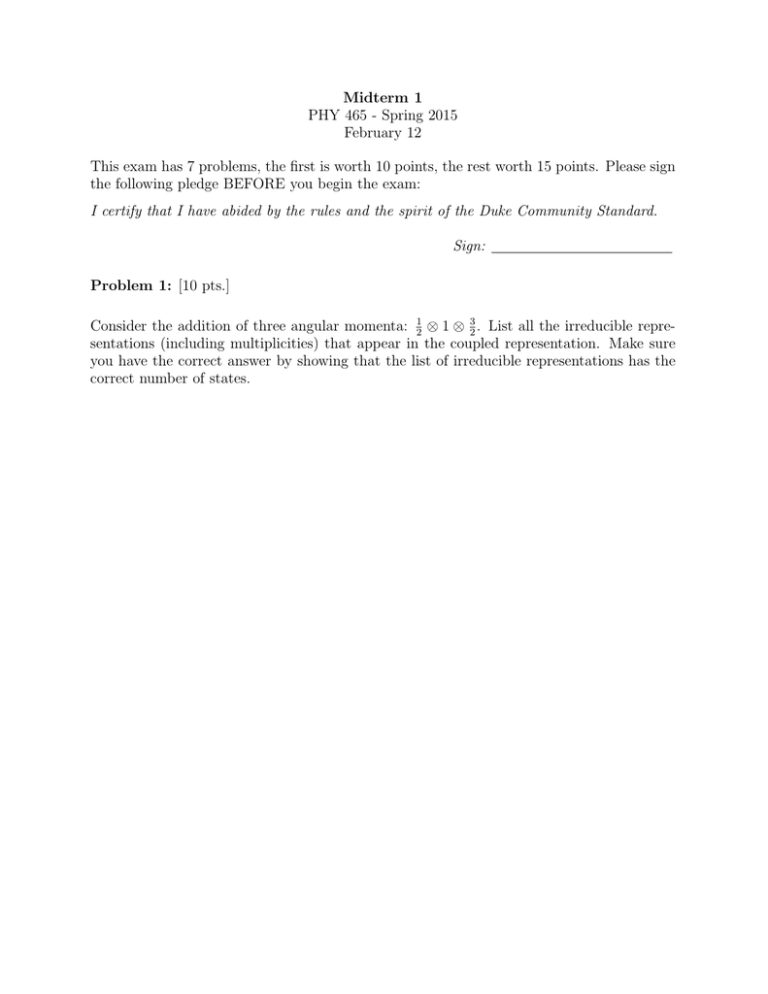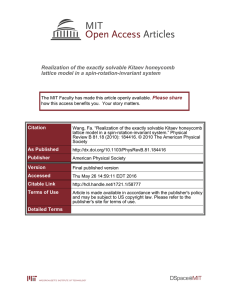Midterm 1 PHY 465 - Spring 2015 February 12
advertisement

Midterm 1 PHY 465 - Spring 2015 February 12 This exam has 7 problems, the first is worth 10 points, the rest worth 15 points. Please sign the following pledge BEFORE you begin the exam: I certify that I have abided by the rules and the spirit of the Duke Community Standard. Sign: Problem 1: [10 pts.] Consider the addition of three angular momenta: 12 ⊗ 1 ⊗ 23 . List all the irreducible representations (including multiplicities) that appear in the coupled representation. Make sure you have the correct answer by showing that the list of irreducible representations has the correct number of states. Problem 2: [15 pts.] A spin-1/2 particle known to be in the state with Sz = +h̄/2 is sent through a SternGerlach device oriented along the n̂-axis, where n̂ = (nx , ny , nz ) = (sin θ, 0, cos θ). What are ~ = +h̄/2? n̂ · S ~ = −h̄/2? probabilities of the S-G device measuring n̂ · S Problem 3: [15 pts.] Relativistic quantum field theory predicts a corrections to the potential energy between a proton and electron that takes the form H0 = − 4h̄3 α2 3 δ (~x) , 15m2e c where α is the fine structure constant and me is the electron mass. Calculate the shift in the ground state energy of the hydrogen atom due to this perturbation. For what values of n, l, m will this perturbation give a nonvanishing correction to the energy levels? Problem 4: [15 pts.] An electrically charged spin-1/2 particle is placed in a uniform magnetic field. The Hamiltonian is ~ ·B ~ H = −γ S Derive the equation of motion for the expectation value of the spin operator: d ~ hSi = ? dt Problem 5: [15 pts.] Consider the following matrix elements for and electron in the Hydrogen atom (ignore spin): M1 = hn0 , l0 , m0 |x2 − y 2 |n, l, mi M2 = hn0 , l0 , m0 |xz|n, l, mi State the selection rules for ∆l = l0 − l and ∆m = m0 − m and find the ratio of the matrix elements in terms of the appropriate Clebsch-Gordan coefficients.. Problem 6: [15 pts.] The Hamiltonian for a rigid rotator in the presence of a magnetic field takes the form ~ 2 + BLz + CLx H = AL ~ is the orbital angular momentum operator, Ly . where A, B, C are constants and L a) What are the eigenfunctions and eigenvalues when C = 0? b) Take C A, B and treat the last term in H as a perturbation. Compute the energy levels up to second order in perturbation theory. c) Solve the problem exactly and compare with your result for part b). Problem 7: [15 pts.] Consider the Hamiltonian for a spin-1/2 particle with angular momentum L = 1: ~ ·S ~. H = −αL a) Find the energy eigenvalues. b) Find the energy eigenfunctions in terms of the spherical harmonics, Ylm (θ, φ) and spin wavefunctions: |Sz = +h̄/2i = 1 0 ! |Sz = −h̄/2i = 0 1 ! . (The Clebsch-Gordan coefficients you will need are included on the equation sheet.) c) A magnetic field is turned on, adding to the Hamilton a term H 0 = βBz (Lz + 2Sz ) . Calculate the shift in the energy using first order perturbation theory.




